 |
Tomahawk
AK 191, Mornington Road, Bolton 17th October 1941 |
 |
Tomahawk
AK 191, Mornington Road, Bolton 17th October 1941 |
Last updated: 24.11.2010
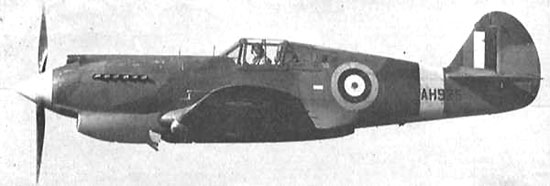 |
|
An RAF Tomahawk fighter. |
| Type | Unit | Base | Duty | Crew |
| Tomahawk |
" HQ S.F.S. |
unknown | Circuits and landings |
1 |
Whilst researching the circumstances behind the loss of Hurricanes PZ 848 and PG 472 in the summer of 2000 we began to find that some locals interviewed knew of other crashes in the area and one or two had confused the details of these and we realised that sometimes they were in fact talking about a completely different incident. This is not an uncommon occurrence and to get a better understanding of what we were hearing, we widened the scope of our research to cover these other crashes as well. The first of these soon proved to be the loss of Blackburn Skua L2892 at nearby Astley Bridge, but another involved a story of a Spitfire engaging in aerobatics and crashing into a house, also nearby, on the Northern edge of Bolton. However, the details differed with each telling with the dates given varying from 1940 through to 1944 and we already knew that if it was a Spitfire then the records were likely to be unavailable. In fact, it proved relatively easy to track down the most likely candidate from our own records of wartime losses over the North West, as we realised that there was only one loss that fitted the story, though it definitely wasn’t the ubiquitous “Spitfire”!
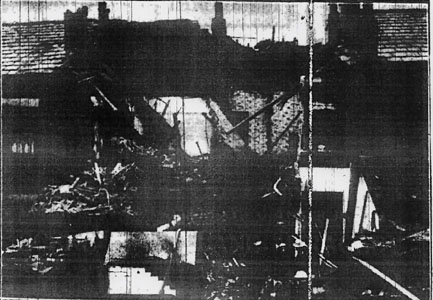 |
|
The rear elevation of No.50 Mornington Road collapsed under the impact of the aircraft and the 80 year old owner who was in the backyard at the time had a miraculous escape without injury. |
The crash occurred on 17the October 1941 when the pilot, Sgt Thomas Blackburn, who was from the area, appears to have arranged to fly over his wife’s house, located on the northern edge of Bolton. The official cause of the crash was given on the Form 1180 as “unauthorised aerobatics + low flying” and the aircraft, an RAF Curtiss Tomahawk (US P-40) fighter, serial No. AK 191, crashed into the roof of No. 50 Mornington Road. Sgt Blackburn was killed in the crash and three people on the ground were lightly injured and required hospital treatment, two of them having been trying to release the pilot from his wrecked aircraft when it burst into flames. Three houses were reported as partly wrecked and several occupants had lucky escapes, if somewhat shocked. The accident and subsequent inquest were covered in some detail in the local newspapers, The Bolton Evening News and the Bolton Journal and Guardian at the time. This was unusual as most such incidents were censored in wartime and copies of the articles were easily traced, as they were indexed in the newspaper cuttings scrapbook at Bolton Library.
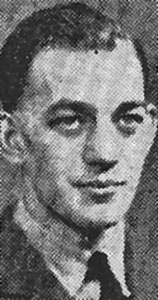 |
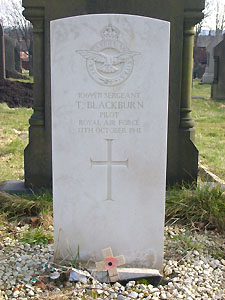 |
| Sgt Thomas Blackburn |
His grave at Astley Bridge |
| Name | Position | Status |
| Sgt. T. Blackburn | Pilot | K. |
The pilot, aged 26, had married in July 1939 and volunteered for the RAF after initially registering for the Army at the outbreak of the war. The CWGC records him as having been on the strength of No. 10 Squadron which was based at Leeming, North Yorkshire and equipped with Whitley Vs at this time, but the Form 1180 records the unit as “HQ S.F.S.”, which is somewhat confusing as it doesn’t appear to match any known unit and it seems that it should perhaps read “SFTS”? (Service Flying Training School) though as no base is given this cannot be confirmed. Sgt Blackburn is recorded as having flown 62 hours under Dual control and 94 Solo, but only two of those solo hours were on the Tomahawk. Also, all his flying experience was within the previous six months, indicating he was probably in the later stages of a pilot training program. The flight was supposed to be “circuits and landings” a training exercise which would normally be carried out in the vicinity of the airfield concerned and the Form 1180 does mention that “Flagrant disregard of flying discipline” was shown by flying his off to visit his home – not that this was an unusual occurrence at the time! Though these official comments do appear unduly harsh today, they are by no means unusual in such cases and as the RAF must have been very aware at this time that losses of trained pilots that were all to often resulting from such unauthorised flights and were unaffordable - it may be that this was some official attempt to dissuade pilots from such actions. However, in this case there does seem to be some discrepancy between the eyewitness accounts appearing in the press and the official line.
One newspaper
reported: “The aircraft was seen by hundreds of people as it rapidly
lost height, but few imagined the pilot was in real trouble until, with a sudden
roll, the plane dropped among the chimney pots of the three houses".
Sgt Blackburn’s wife was one of the witnesses and saw a flight of three planes
– she watched them all “and none of them did aerobatics”. She also
saw the plane crash and although she was expecting her husband to fly over
during the day, she was unsure at the time if he had been in any of the
aircraft. At the inquest, one witness stated that he saw the plane “turn
over and begin to wobble” – it then dived towards the houses, another
saw the plane on its back, then right itself before turning over again – he
then saw “black smoke from the airplane, which dived into the houses”.
Only one witness is recorded as actually stating that the aircraft gave “a
display of aerobatics, just before the crash”, but as he held an “A”
Flying Certificate, this was apparently considered sufficient for an RAF officer
to be satisfied that “the crash was due to an attempt by Sgt Blackburn to
perform an evolution at a low altitude”.
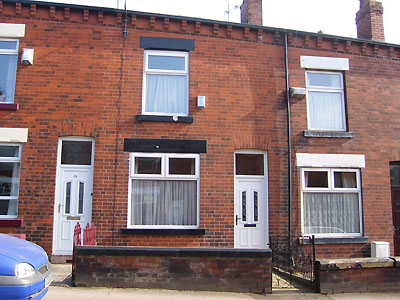 |
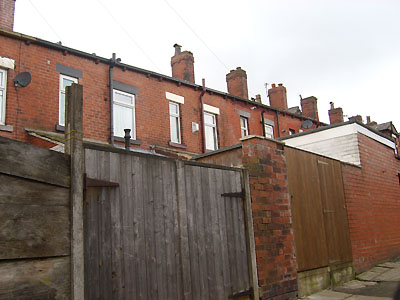 |
| From the front No. 50 Mornington road today shows no evidence of the drama nearly 70 years before. | The rear elevation was rebuilt with almost identical materials and only a join in the brickwork is visible - It is not known if the missing chimney stack was rebuilt or not. |
Whatever the truth behind this tragic accident, it should be remembered that
throughout WW2 the temptation for pilots to divert from their allotted flight
paths to fly over relative's or girlfriend's homes, often indulging in some
unofficial aerobatics at the same time, seems to have been irresistible. Perhaps
in light of the realities of wartime, where the future must have seemed
uncertain and pilots were already risking their lives on a daily basis, any
additional danger posed by such antics did not worry them unduly and we should
not view such high jinks too harshly. However, all to often they ended in
disaster such as here and surely the most tragic of accidents must be those
which occurred within sight of the families of the pilots concerned? Sgt
Blackburn is buried at Bolton (Astley Bridge) Cemetery, Div. 1 A. Sec. P. C of
E. Grave 82.
Acknowledgements:
Mark Gaskell, Alan
Clark, Bolton Library, Gordon Acornley.
This page & all articles on this site Copyright © Nick Wotherspoon 2010